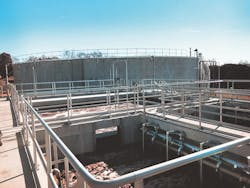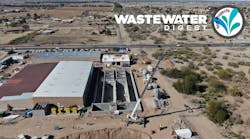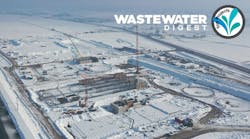Cost: $4 million
Location: Peach Glen, Pa.
Year: 2018-12-01
Size: 275,000 gpd
Owner: Arcadis
Designers: ADI Systems
Contractor: ADI Systems
Knouse Foods specializes in products such as pie fillings and applesauce. The headquarters plant is in Peach Glen, Pa., where workers process apple products most of the year, as well as peaches and cherries for the Musselmann’s and Lucky Leaf brands.
The company needed a solution to responsibly manage organic food waste and wastewater from its fruit processing. It did not just want to dispose of the waste. It wanted to turn something that would usually be wasted into something valuable. By investing in onsite anaerobic digestion, Knouse Foods could tap into the power of biogas, helping the environment—and the fruit processor’s bottom line.
“Biogas generated from anaerobic digestion is first scrubbed in a biological scrubbing system to reduce the hydrogen sulfide concentration in the biogas. Scrubbed biogas is cooled to reduce the moisture content, then transmitted to a 1.2-MW dual-fuel genset,” said Daniel Bertoldo, process engineer for ADI Systems.
The natural gas is blended with the treated biogas to maintain a target electrical power output. Waste heat from the genset is then recovered to generate steam. Bertoldo said Arcadis and Martin Energy Group were instrumental in the design and commissioning of the biogas scrubbing and utilization systems.
“The most important goal was to be able to process and treat the wastewater of the facility to meet discharge effluent quality levels,” said Robert Woerner, director of engineering and development for Knouse Foods. “The facility started discharge in Oct. 2017 and has been effectively treating wastewater and meeting quality levels.”
The treatment system consists of a 2.35-million-gal low-rate ADI-BVF reactor for anaerobic pretreatment and an ADI membrane reactor for aerobic polishing. The process train was chosen after a successful five-month pilot study conducted at the plant that demonstrated the benefits of ADI Systems’ technology compared to a major competitor.
“The biggest obstacle during the project was designing a system to treat wastewaters of the facility with limited previous wastewater quality information,” Woerner said. “Sampling was completed and wastewater treatment was validated by means of small-scale pilot systems, which provided information for successful full-scale design and use in permitting of the system."
The ADI-BVF reactor is designed to accept macerated food waste, which increases the biogas production and allows Knouse Foods to dispose of food waste for multiple plants in the area. The biogas is scrubbed to remove hydrogen sulfide and is utilized in a 1-MW dual-fuel genset.
“Solids-grinding and fine-screening systems have been installed at the Peach Glen wastewater treatment plant. Residual food waste from three of Knouse Foods’ local production plants can be trucked to the treatment plant, macerated and screened, then fed to the anaerobic digester,” Bertoldo said.
This not only reduces the quantity of food waste sent to landfill, but also increases the biogas production rate in the anaerobic digester. This maximizes the amount of recoverable green energy generated from plant waste and demonstrates the company’s environmental stewardship by diverting food solids away from landfills.
“Knouse Foods selected anaerobic and aerobic technologies which have designs that inherently produce consistent quality effluent. The low-rate BVF reactor serves as the workhorse of the treatment plant and removes the vast majority of the organic load in the wastewater,” Bertoldo said. “The consistent quality anaerobic effluent simplifies the operation of the downstream [membrane bioreactor] system, which is designed to achieve biological nutrient removal. The pairing and appropriate sizing of BVF and MBR technologies ensures that weekly and seasonal fluctuations in flow and organic load are attenuated and treated, resulting in a final effluent which consistently meets tight discharge limits.”
The new treatment system is addressing byproducts of its manufacturing operations, helping the fruit processor achieve environmental compliance. The combination of technologies generates a high-quality final effluent, allowing Knouse Foods to meet very strict discharge limits to release to the local Bermudian Creek.
“With about a year of operation and positive results, Knouse Foods has been satisfied with the wastewater treatment system,” Woerner said.
Click here to read more about the 2018 iWWD Top Projects.


